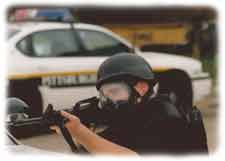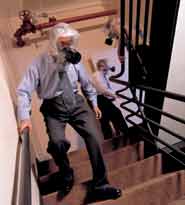Whether tornadoes or
terrorists attack, the need for personal protection is obvious
for First Responders (firefighters, emergency  medical
services, law enforcement). However, ANYONE within the disaster
area for any reason will need personal protection, including
government employees; construction and utility workers; hospital
personnel; and volunteers. Could this be you? medical
services, law enforcement). However, ANYONE within the disaster
area for any reason will need personal protection, including
government employees; construction and utility workers; hospital
personnel; and volunteers. Could this be you?
MSA’s
attractive new 18-page product bulletin addresses the need
for and use of Personal Protective Equipment (PPE) for Homeland
Security in four key activity phases: "Readiness, Response,
Rescue, and Recovery." Accenting the pages are photos
and quotations related to sites on which terrorists have
attacked America. (Besides the 9-11 disaster sites, the
Oklahoma City Murrah Building and other sites are represented.)
Each phase of action is briefly described.
• "Readiness" is most important: the time
to assess, plan, prepare, and train for the event.
• "Response" is the immediate reaction to
an attack.
• "Rescue" involves saving victims, and
• "Recovery" extends from reclaiming victims
to eventual remediation of the site.
Thumbnail descriptions introduce 70 MSA
products in this bulletin designed for both easy skimming
and detailed reading. You’ll also find "lessons
learned" at a December 2001 NIOSH conference, Web site
links and publications, and information about Weapons of
Mass Destruction.
Request a copy of this bulletin by filling
out the FAX-BACK form on page 8, or call 1-800-MSA-2222
or your MSA distributor. You can also view a pdf of the
Homeland Security bulletin at www.MSAFIRE.com.
|
| Being
prepared
Adrenaline isn’t enough.
The engineers and miners who rescued the
miners from Pennsylvania’s Quecreek Mine on July 28,
2002, did not need MSA to supply any personal protection
and equipment, because they already had what they needed.
Their safety gear was at hand; their experience and training
fortified them on the line.
 Law
enforcement officers and firefighters train as vigorously
and regularly as any military troops for “what might
happen.” They wear many layers of protective equipment,
so when the time comes to respond to hostage situations
or raging infernos, their minds are on the job, not how
bulky their clothing is. Police don gas masks, heavy Kevlar
clothing, helmets, etc., to simulate reality for target
practice on firing ranges. Law
enforcement officers and firefighters train as vigorously
and regularly as any military troops for “what might
happen.” They wear many layers of protective equipment,
so when the time comes to respond to hostage situations
or raging infernos, their minds are on the job, not how
bulky their clothing is. Police don gas masks, heavy Kevlar
clothing, helmets, etc., to simulate reality for target
practice on firing ranges.
Thousands of potential victims escaped
death on September 11, 2001, because for years, First Responders
had made realistic evacuation exercises as familiar as breathing.
They already knew how it feels to race up multiple flights
of stairs with 40 pounds of equipment. When confronted with
disasters beyond their imagination and training, they could
still make a tremendous difference.
BEFORE using PPE, wearers MUST be trained
in its use and understand it enough to answer questions
like: “Is this product appropriate for this use? What
are its limitations? What will it do for me—for how
long?”
AFTER confronting a crisis, First Responders
must review how well their procedures and equipment, communication,
and supportive resources worked. Where were the weaknesses?
“The full-face respirator worked
the best... we [HazMat team members] slapped cartridges
on [our] full-face... to handle just about everything. We
had voice amplifiers [to] communicate. [Responders wearing]
just a half-face [mask], their communications went down
quickly,” reported a firefighter-special-operations
panel member, at the Dec. 2001 NIOSH conference on Protecting
Emergency Responders.
To discuss your Homeland Security
needs for gas masks and other MSA protection and instruments,
call your MSA distributor or 1-800-MSA-2222.
|
 |
 |
|
“[Our
recommendations] since the September 11 attacks are the
same as always: Be prepared for every emergency. It's
just that people are paying more attention now, ”
commented Rocky Lopes of the American Red Cross office
of preparedness.

|
Real
People on the Job
Pete Gasparich, an Ironworker
in Local 40, and his buddies worked at Ground Zero for
months.  As
he related early in March 2002: “We were working
a job across the river when I saw the Trade Center get
hit...We jumped in our trucks, hurried over to help...already
wearing our safety gear. But oh, that smoke, all that
particulate! As
he related early in March 2002: “We were working
a job across the river when I saw the Trade Center get
hit...We jumped in our trucks, hurried over to help...already
wearing our safety gear. But oh, that smoke, all that
particulate!
“Those first days,
FEMA had it under control. Then we did whatever the Fire
Department told us to do. Then, whoever was in charge
of the rig. . . .
“It broke my
heart...I spent a year of my life building WTC 7. Now
that we’ve reached this stage of recovery, we really
don’t want to go to work...But--after we clean the
site up, we’ll probably build again. That’s
what we do.”
|
|